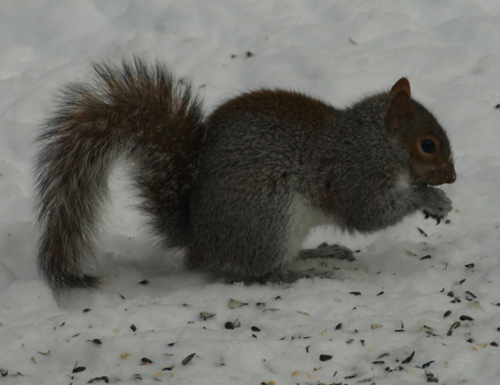Gray squirrels abound in Connecticut. They have gray fur above, but if you look closely you will see brown and tan tones mixed in. The underbelly fur is whitish. They carry a trademark bushy gray tail a bit longer than the length of their body. They weigh roughly 1 to 1.5 pounds. There is also a black-furred form of the eastern gray squirrel.
These squirrels range through the eastern half of the US. They are active year-round. They will nest in tree cavities and build leaf nests that look like wads of leaves stuffed in the treetops.
Typical diet in the wild consists of tree nuts such as hickory nuts, beech nuts and acorns. Individual nuts are buried for the winter in shallow holes in the ground. The squirrels don't seem to remember where they personally have buried nuts, but use their sense of smell to find nuts stored underground. The fact that squirrels recover many but not all of such stored nuts makes them a vector in tree propagation. Squirrels will also eat buds, bark, mushrooms, fruits and some insects. The gray squirrel is a frequent visitor at backyard birdfeeders. Great effort has gone into designing squirrel-proof birdfeeders, but these determined creatures often still manage to find a way to raid the birdseed.
Squirrels mate in mid-winter, and often produce a spring litter as well as a second litter later in the summer.
If you've seen a squirrel on the ground run for cover, you may have noted how they tend to spiral up a tree trunk, making them hard to see as they escape. An annoyed or alarmed squirrel will flick its tail and holler "Chee... Chee... Chee...!" from the safety of a high branch.
Neat Fact
Acorns that fall from the red oak family are dormant and wait until the following spring to germinate while acorns from the white oak family germinate much earlier. You will see white oak acorns starting to sprout shortly after dropping when conditions are right. Gray squirrels will selectively cache red oak acorns and will eat the white oak acorns immediately. If there is an abundance of white oak acorns and fewer red oak acorns, the squirrel will nibble off the end of white oak acorns, removing the bit that contains the embryonic plant. This prevents sprouting and allows the white oak acorn to be stored for the winter for a much longer period.
